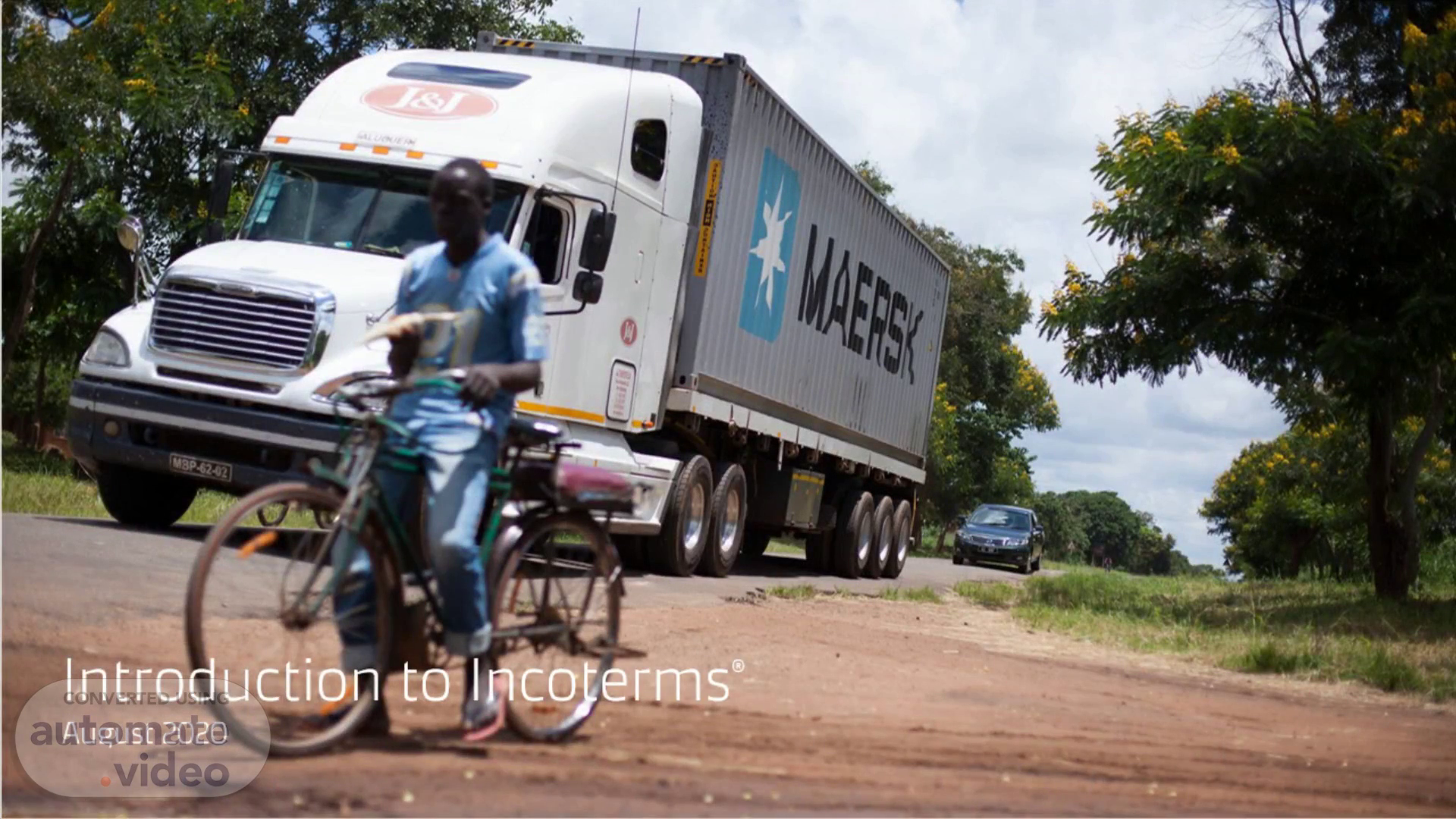
Introduction to Incoterms® August 2020
Scene 1 (0s)
Introduction to Incoterms ® August 2020. Insert presentation title via Header & Footer.
Scene 2 (6s)
[Audio] Learning Objectives By the end of this session, you will: be able to explain why Incoterms have been created, and their recognition in international trade; know how the Incoterms are categorised, named, and defined; be able to articulate the points of cost & risk transfer from Seller to Buyer for each term.
Scene 3 (31s)
[Audio] Contents. .. Background of Incoterms Incoterms Overview The Four Categories of Incoterms Group E Group F Group C Group D Incoterms in Detail: Obligations of Buyer & Seller.
Scene 4 (42s)
[Audio] We will be discussing " Background of Incoterms".
Scene 5 (47s)
[Audio] Among the challenges in conducting export sales is agreeing on the details for transporting goods across borders. 2) A typical export will move through four storage facilities; the domestic carrier's facility, the export terminal, the import terminal and the buyer's receiving dock… 3) …and change hands at least five times; the shipper, the domestic ground carrier, the international carrier, the ground carrier in the import nation and finally the buyer. 4) Either the seller or the buyer needs to make arrangements for transport and import customs clearance. The two parties must also agree on which has responsibility for the goods in case the shipment is damaged, lost or stolen. For centuries these issues were handled by tradition and standard practice, which often varied from nation to nation. Disputes would arise when ever there were differences in the understanding of the obligations. The International Chamber of Commerce ( ICC) has addressed the difficulty by establishing a common set of rules that apply to all international sales. The first set of rules, called " Incoterms 1936" short for international commercial terms, was published in 1936. The standard has been updated eight times since then, the current standard is called Incoterms 2020. The United Nations Commission on International Trade Law recognises Incoterms 2020. This makes the it a worldwide standard and legally binding in contracts for parties conducting international trade..
Scene 6 (2m 33s)
Background of Incoterms ®. .. Terms of Sale?. Among the challenges in conducting export sales is agreeing on the details for transporting goods across borders..
Scene 7 (2m 47s)
A sign in the dark Description automatically generated.
Scene 8 (3m 0s)
A sign in the dark Description automatically generated.
Scene 9 (3m 13s)
A sign in the dark Description automatically generated.
Scene 10 (3m 30s)
A sign in the dark Description automatically generated.
Scene 11 (4m 3s)
[Audio] We will be discussing " Incoterms Overview".
Scene 12 (4m 14s)
[Audio] What are Incoterms®?A set of 11 trade terms used in contracts for the sale and purchase of goods; Incoterms® are not law, yet the commercial contract in which they are used can be legally binding; They describe the obligations, costs, and transfer of risk; General rules of thumb: The party responsible for arranging transportation, and payment of transportation charges is in control of the cargo; The more responsibility the party has, the more control they have, and the more risks they bear ( customs, licencing, freight, other formalities)..
Scene 13 (4m 55s)
[Audio] Incoterms® do not…Automatically apply. They must be specified; Determine ownership, transfer of title or ownership of goods; Determine payment terms between seller and buyer; Protect parties from their own risk or loss, nor cover the goods before or after delivery. This is what insurance is for..
Scene 14 (5m 20s)
[Audio] What's changed since Incoterms® 2010? The Incoterm DAT (Delivered at Terminal) is replaced by DPU (Delivered at Place Unloaded). Although this may appear to be merely a name change as the obligations and responsibilities remain the same, the new DPU term covers delivery to any agreed place including, but not limited to, delivery at terminal. There are new insurance requirements under Incoterms CIF and CIP. In shipping, under the Incoterm FCA the buyer can ask the shipping company or their agent to issue a Bill of Lading to the seller with the notation "on board"..
Scene 15 (6m 1s)
[Audio] Incoterms® OverviewResponsibility Matrix – Obligations of Importer ( Buyer) and Exporter ( Seller).